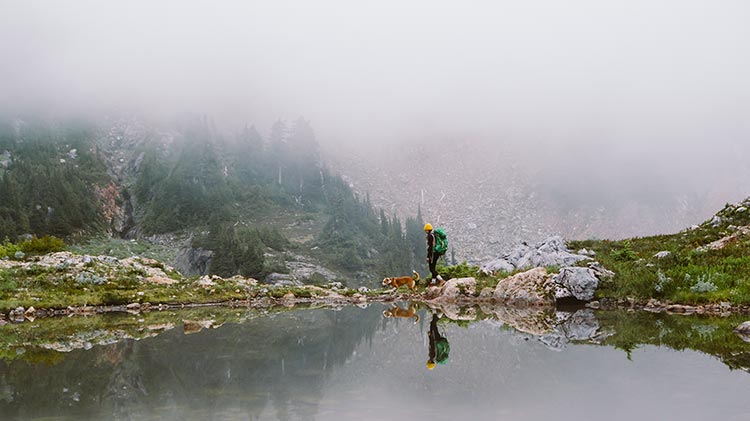Adventure Smarter
With 2021 shaping up to be a busy summer in the backcountry, Leave No Trace principles are more crucial than ever—and can help you return home safely too
By Ryan Stuart
I never go to Paradise Meadows thinking I’ll be alone. The aptly named arm of Strathcona Provincial Park is the only sub-alpine on Vancouver Island accessible by paved road. Hiking trails loop through hills covered in old-growth forest, lakes reflecting snowy peaks and abundant open marshes. In other words, it’s a hiking paradise and popular because of it.

But last summer it was something else. On a July weekday I arrived at the trailhead parking lot to find it full. The only other time I’d seen that was on busy weekends in the winter, when it serves as the base area for Mount Washington Alpine Resort‘s cross-country ski network.
There were lineups at the nicest viewpoints. Along the hike l passed dozens of groups, saw some people heading off-trail in search of solitude and filled a plastic bag with garbage.
This likely sounds familiar to anyone who went hiking, biking, climbing, paddling or spent any time in nature last summer. There were regular reports of overflowing parking lots and garbage cans, lineups for outhouses and overused trails. Most people were doing the right thing, but no matter how gently we try to travel, all those boots have an impact and it’s not just on the land. The rush outdoors meant volunteer search and rescue crews were busier too.
The number of callouts increased about 30 percent across the province.
“It’s not that people are being reckless,” says Marc D’ Aquino, an emergency planning consultant and search and rescue trainer. “It’s just that the sheer number of people increases the probability of an accident or injury.”
Considering how much use of wild places increased, the number of rescues was remarkably low, he says. But it could be better. And the key to reducing incidents relies on the same practices that will make hiking in a place like Paradise Meadows more pleasant and maintain parks and trails for generations to come. It all comes down to Leave No Trace.
Developed in the early 1990s, LNT consists of seven principles: plan ahead and prepare; travel and camp on durable surfaces; dispose of waste properly; leave what you find; minimize campfire impacts; respect wildlife; and be considerate of other visitors.
The first is especially important in a busier backcountry, says Dana Watts, the executive director of the Centre for Outdoor Ethics, the keepers and promoters of LNT.
“When you plan ahead you’re already thinking about safety and comfort,” she says. “You’re already thinking about how you’ll have less impact on the environment and search and rescue crews.”
It breaks down to three Ts, says Dwight Yochim, the senior manager for BC Search and Rescue Association: trip planning, training and taking the essentials. Looking back on trends from last year’s operations, he says, those three steps would have prevented most rescues.
“We got lots of calls for people who were on a hike that took a lot longer than they expected and lost the light,” he says. “When we find them, they’re in jeans and sneakers with no water or snacks. The increase in unprepared and inexperienced people is concerning.”
Especially because being prepared is not hard. A trip planning tool lays out the steps and the process serves as a second thought to make sure the objective fits the person’s training and capabilities, says Yochim. The next step is to write down the trip plan and let someone know when you’ll return.
It seems like overkill in Paradise Meadows. There are enough other people on the trail that I stop saying hello to everyone I pass. But I know there are plenty of spots in the rolling hills where a cell signal is nonexistent. The weather changes fast. It doesn’t take much bad luck to turn a badly sprained ankle into a night out.
As I meandered through Paradise Meadows last summer l was thinking about all of this. But I was also noticing how everyone was smiling. Yeah, the trail was busy, but it was still a little piece of paradise that felt a long way from lockdowns and mask mandates. Basking in the sun with dozens of others spread along the shore at Lake Helen McKenzie I remembered the final Leave No Trace principle: be considerate of others.
In a busier backcountry it might be the most important idea of all.
Trip Planning App
The best way to ace trip planning is with the Adventure Smart app. Developed by Adventure Smart, a national program working to educate the public to prevent rescues, it’s free and IOS and Android compatible. The app walks you through the four key questions of trip planning. Who is going? When? Where? And what are you bringing? Once filled out, it automatically sends all the information to a contact, along with a planned return time. If they’ve got the app too, it alerts them if you’re running late.
“The app is crucial to lowering SAR call volumes,” says Marc D’Aquino, an emergency management consultant. “It forces you to think through your plan and go prepared. It’s so easy to do there’s no reason to go into the backcountry without it.”
Go to adventuresmart.ca for more info.
This article was originally featured in BC Mag’s Summer 2021 issue and on BCMag.com on October 5th, 2021.



